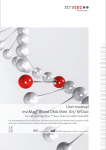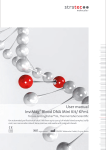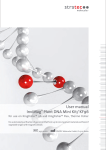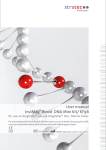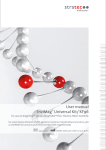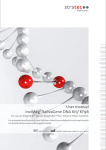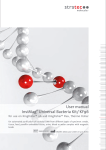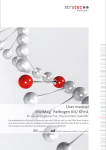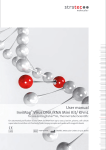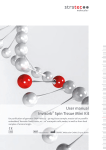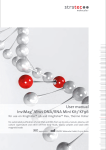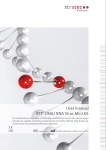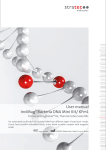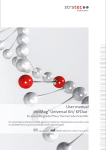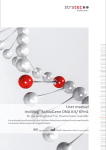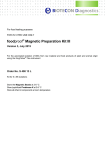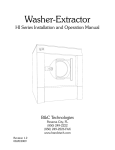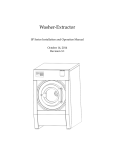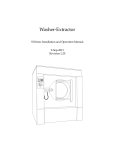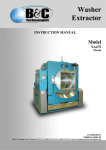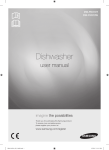Download InviMag Tissue DNA Mini Kit/ KF96
Transcript
User manual InviMag® Tissue DNA Mini Kit/ KF96 for use on KingFisher® 96 and KingFisher® Flex, Thermo Fisher for automated purification of genomic DNA from up to 20 mg of tissue sample, mouse or rodent tail, paraffin embedded tissue, formalin fixed tissue, and eucaryotic cell pellets with magnetic beads IVD REF 7432300x00 STRATEC Molecular GmbH, D-13125 Berlin Instruction for InviMag® Tissue DNA Mini Kit/ KF96 The InviMag® Tissue DNA Mini Kit/ KF96 combines the advantages of the innovative Invisorb® technology with easy handling of magnetic particles for a very efficient and reliable isolation of nucleic acids with a high purity. The DNA-binding magnetic particles are characterized by a high surface area, a uniform size distribution, and good suspension stability and are therefore highly suitable for high throughput processing. The InviMag® Tissue DNA Mini Kit/ KF96 for isolation and purification of total (genomic and mitochondrial) DNA from tissue samples, biopsy samples, frozen sections, rodent tails, insects, paraffin embedded tissue, formalin fixed tissue (FFPE), and eucaryotic cell pellets in a 96 well format is designed for an optimal use on the KingFisher® 96 or Flex workstation from Thermo Scientific. The interplay of the DNA extraction and purification chemistry provided by the InviMag® Tissue DNA Mini Kit/ KF96 with the KingFisher machine was intensely tested and validated. Due to the high purity, the isolated DNA is ready to use for in vitro diagnostic analysis and for a broad panel of downstream applications or can be stored at -20°C for subsequent use. The kit is neither suitable for isolation of DNA from blood, stool sample, swabs, dried blood stains or cell free body fluids, like cerebrospinal fluid, synovial fluid and urine nor from bacteria, plant material, fungi, parasites or the purification of RNA. The application of the kit for isolation and purification of viral DNA has not been evaluated. IVD Compliance with EU Directive 98/79/EC on in vitro medical devices. Not for in vitro diagnostic use in countries where the EU Directive 98/79/EC on in vitro medical devices is not recognized. Trademarks: InviMag®, Invisorb®. Registered marks, trademarks, etc. used in this document, even when not specifically marked as such, are not to be considered unprotected by law. The Invisorb® technology is covered by patents and patent applications: US 6,110363, US 6,043,354, US 6,037,465, EP 0880535, WO 9728171, WO 9534569, EP 0765335, DE 19506887, DE 10041825.2, WO 0034463. InviMag® and Invisorb® are registered trademarks of STRATEC Biomedical AG. The PCR process is covered by US Patents 4,683,195, and 4,683,202 and foreign equivalents owned by Hoffmann-La Roche AG. © 2015 STRATEC Molecular, all rights reserved. ® 1 InviMag Tissue DNA Mini Kit/ KF96 0515 Table of Content Kit contents of InviMag® Tissue DNA Mini Kit /KF96 3 Kit contents of InviMag® Tissue DNA Mini Kit /KF96 w/o plastic 4 Symbols 5 Storage 5 Quality control and product warranty 5 Intended use 6 Product use limitation 6 Safety information 7 Product characteristic of the InviMag® Tissue DNA Mini Kit /KF96 8 Sampling and sample storage of the starting material 9 Principle and procedure 10 Yield and quality of genomic DNA 10 Scheme of the InviMag® Tissue DNA Mini Kit /KF96 11 Important notes 12 Preparing reagents and buffers 12 Reagents and equipment to be supplied by user 12 Important indications for the InviMag® Tissue DNA Mini Kit /KF96 14 Protocol 1: Isolation of genomic DNA from up to 20 mg tissue 14 Protocol 2: Isolation of genomic DNA from paraffin embedded tissue 15 Protocol 3: Isolation of genomic DNA from formalin fixed tissue or formalin-fixed paraffin - embedded tissue (FFPE) 16 Protocol 4: Isolation and purification of DNA from eucaryotic cells 17 Starting a run on a KF96 / KFflex96 instrument 19 For self-programming of the KF96 and KFflex96 instrument 21 Troubleshooting 23 Appendix 24 General notes on handling DNA 25 Ordering Information 26 ® 2 InviMag Tissue DNA Mini Kit/ KF96 0515 Kit contents of InviMag® Tissue DNA Mini Kit/ KF96 Store the MAP Solution A at 2-8°C! Store dissolved Proteinase K at -20°C! Store all other kit components at room temperature (RT)! 1 x 96 extractions 5 x 96 extractions Catalogue No. 7432300100 7432300200 Lysis Buffer G 50 ml 220 ml 9 ml (final volume 30 ml) 36 ml (final volume 120 ml) 3 x 1 ml 13 ml 2 x 1.2 ml 10.5 ml* Binding Buffer A Proteinase K (working solution) MAP Solution A 2 x 45 ml 6 x 60 ml final volume 2 x 150 ml final volume 6 x 200 ml 30 ml 120 ml 2.0 ml Deep Well Plate 4 20 KF 96 Tip Comb for DW magnets 1 5 200 µl Elution Plate* 2 2x5 2 x 50 10 x 50 Sealing Foils 2 10 Manual 1 1 Wash Buffer Elution Buffer 1.5 ml Receiver Tubes Initial steps Add 21 ml of 99.7% Isopropanol to the Binding Buffer A. Mix by intensive shaking by inverting for 1 min. Add 84 ml of 99.7% Isopropanol to the Binding Buffer A. Mix by intensive shaking by inverting for 1 min. Dilute Proteinase K by addition of 1 ml of ddH2O, mix thoroughly until completely dissolving and store at 20°C! Dilute Proteinase K by addition of 13 ml of ddH2O, mix thoroughly until completely dissolving and store at 20°C! Add 105 ml of 96-100% ethanol to the bottle Wash Buffer, mix thoroughly and keep the bottle always firmly closed! Add 140 ml of 96-100% ethanol to the bottle Wash Buffer, mix thoroughly and keep the bottle always firmly closed! *Divide the MAP Solution into aliquots according your need. * Elution Plates and Tip Plates are the same. Use one provided Elution Plate as a Tip Plate. ® 3 InviMag Tissue DNA Mini Kit/ KF96 0515 Kit contents of InviMag® Tissue DNA Mini Kit/ KF96 w/o plastic Store the MAP Solution A at 2-8°C! Store dissolved Proteinase K at -20°C! Store all other kit components at room temperature (RT)! 1 x 96 extractions 5 x 96 extractions Catalogue No. 7432300150 7432300250 Lysis Buffer G 50 ml 220 ml 9 ml (final volume 30 ml) 36 ml (final volume 120 ml) 3 x 1 ml 13 ml 2 x 1.2 ml 10.5 ml* 2 x 45 ml final volume 2 x 150 ml 6 x 60 ml final volume 6 x 200 ml Elution Buffer 30 ml 120 ml 1.5 ml Receiver Tubes 2 x 50 10 x 50 Sealing Foils 2 10 Manual 1 1 Binding Buffer A Proteinase K (working solution) MAP Solution A Wash Buffer Initial steps Add 21 ml of 99.7% isopropanol to the Binding Buffer A. Mix by intensive shaking by inverting for 1 min. Shortly before use mix by inverting several times. Add 84 ml 99.7% isopropanol to the Binding Buffer A. Mix by intensive shaking by inverting for 1 min. Shortly before use mix by inverting several times. Dilute Proteinase K by addition of 1 ml of ddH2O, mix thoroughly until completely dissolving and store at -20°C! Dilute Proteinase K by addition of 13 ml of ddH2O, mix thoroughly until completely dissolving and store at 20°C! Add 105 ml of 96-100% ethanol to the bottle Wash Buffer, mix thoroughly and keep the bottle always firmly closed! Add 140 ml of 96-100% ethanol to the bottle Wash Buffer, mix thoroughly and keep the bottle always firmly closed! *Divide the MAP Solution into aliquots according your need. Plastic to be supplied by user (see order information) 2.0 ml Deep Well Plate 4 20 KF 96 Tip Comb for DW magnets 1 5 200 µl Elution Plate* 2 10 * Elution Plates and Tip Plates are the same. Use one provided Elution Plate as a Tip Plate. ® 4 InviMag Tissue DNA Mini Kit/ KF96 0515 Symbols Manufacturer Lot number Catalogue number Expiry date Consult operating instructions Temperature limitation Do not reuse Storage All reagents and kit contents of the InviMag® Tissue DNA Mini Kit/ KF96, except MAP Solution A, are stable for at least 12 months. MAP Solution A is stable for at least 6 months. All buffers and kit contents of the InviMag® Tissue DNA Mini Kit/ KF96, except dissolved Proteinase K and MAP Solution A, should be stored at room temperature (RT). Proteinase K: Dissolved Proteinase K must be stored at -20°C. Dividing the Proteinase K into aliquots and storage at -20°C is recommended. MAP Solution A: The magnetic beads should be stored at 2-8°C. Wash Buffers / Binding Buffer: Wash Buffers and Binding Buffers charged with either ethanol or isopropanol should be stored at room temperature* and must be appropriately sealed. If there are any precipitates visible within the provided solutions dissolve them by carefully warming up to room temperature (up to 30°C). 1 M DTT (not provided): Store the 1 M DTT solution at -20°C to prevent oxidative damage. The DTT solution is stable for 12 months at this condition. Room temperature (RT) is defined as range from 15-30°C. Quality control and product warranty STRATEC Molecular warrants the correct function of the InviMag® Tissue DNA Mini Kit/ KF96 for applications as described in this manual. Purchasers must determine the suitability of the product for its particular use. Should any product fail to perform in the applications described in the manual, STRATEC Molecular will check the lot and if a problem is approved, STRATEC Molecular will replace the product free of charge. STRATEC Molecular reserves the right to change, alter or modify any product to enhance its performance and design at any time. In accordance with STRATEC Molecular’s ISO 9001-2000 and ISO EN 13485 certified Quality Management System the performance of all components of the InviMag® Tissue DNA Mini Kit / KF96 is tested separately against predetermined specifications routinely on lot-to-lot to ensure consistent product quality. If you have any questions or problems regarding any aspects of InviMag® Tissue DNA Mini Kit/ KF96 or other STRATEC Molecular products, please do not hesitate to contact us. A copy of STRATEC Molecular’s terms and conditions can be obtained upon request or are presented at the STRATEC Molecular webpage. ® 5 InviMag Tissue DNA Mini Kit/ KF96 0515 For technical support or further information please contact: from Germany +49-(0)30-9489-2901/ 2910 from abroad +49-(0)30-9489-2907 or contact your local distributor. Intended use The InviMag® Tissue DNA Mini Kit/ KF96 is designed for semi-automated extraction and purification of total (genomic and mitochondrial) DNA from up to 96 tissue or tissue related samples using magnetic beads and the KF96 / KFflex96 instrument. The provided nucleic acid isolation protocols are suitable for semi-automated preparation of DNA from fresh or frozen tissue samples, biopsy samples, frozen sections, rodent tails, insects, paraffin embedded tissues, formalin fixed tissues, and eucaryotic cell pellets. For reproducible and high yields an appropriate sample storage is essential (see “Sampling and storage of the starting material”, page 9). All utilities (reagents and plastic ware) necessary for preparation of total DNA are provided by the InviMag® Tissue DNA Mini Kit/ KF96 in different package sizes. The procedures of the InviMag® Tissue DNA Mini Kit/ KF96 have been optimized for the isolation of total DNA from up to 20 mg tissue sample, app. 0.5 cm rodent tail or 1 x 106 eucaryotic cells. THE PRODUCT IS INTENDED FOR USE BY PROFESSIONALS SUCH AS TECHNICIANS, PHYSICIANS AND BIOLOGISTS TRAINED IN MOLECULAR BIOLOGICAL TECHNIQUES. It is designed to be used with any downstream application employing enzymatic amplification or other enzymatic modifications of DNA followed by signal detection or amplification. Any diagnostic results generated by using the sample preparation procedure in conjunction with any downstream diagnostic assay should be interpreted with regard to other clinical or laboratory findings. To minimize irregularities in diagnostic results, adequate controls for downstream applications should be used. The kit is in compliance with EU Directive 98/79/EC on in vitro medical devices. But it is not for in vitro diagnostic use in countries where the EU Directive 98/79/EC on in vitro medical devices is not recognized. Product use limitation The kit is neither validated for the isolation of DNA from stool samples, whole blood, bacteria, fungi or viruses, nor for isolation and purification of RNA The included chemicals are only useable once. If the flow trace or starting material is changed, no issue in operability will be given. The user is responsible to validate the performance of the STRATEC Molecular product for any particular use. STRATEC Molecular does not provide for validation of performance characteristics of the product with respect to specific applications. STRATEC Molecular products may be used e.g.in clinical diagnostic laboratory systems conditioned upon the complete diagnostic system of the laboratory the laboratory has been validated pursuant to CLIA’ 88 regulations in the U.S. or equivalents in other countries. All products sold by STRATEC Molecular are subject to extensive quality control procedures (according to ISO 9001-2000 and ISO EN 13485) and are warranted to perform as described herein. Any problems, incidents or defects shall be reported to STRATEC Molecular immediately upon their detection. The reagents and plastic parts are for laboratory use only. They must be stored in the laboratory and must not be used for other purposes than intended. The kit and its contents are unfit for consumption. ® 6 InviMag Tissue DNA Mini Kit/ KF96 0515 Safety information When and while working with chemicals, always wear a suitable lab coat, disposable gloves, and protective goggles! Avoid direct skin contact! Adhere to the legal requirements for working with biological material! For more information, please consult the appropriate material safety data sheets (MSDS). These are available online in convenient and compact PDF format at www.stratec.com for each STRATEC Molecular kit and its components. If buffer bottles are damaged or leaking, WEAR GLOVES, AND PROTECTIVE GOGGLES when discarding the bottles in order to avoid any injuries. STRATEC Molecular has not tested the liquid waste generated by the InviMag® Tissue DNA Mini Kit/ KF96 procedures for residual infectious materials. Contamination of the liquid waste with residual infectious materials is highly unlikely, but cannot be excluded completely. Therefore, liquid waste has to be considered infectious and be handled and discarded accordingly to local safety regulations. European Community risk and safety phrases for the components of the InviMag® Tissue DNA Mini Kit/ KF96 to which they apply, are listed below as follows: Proteinase K danger H315-319-334-335 P280-305-351-338-310-405 H315: H319: H334: H335: P280: P305+P351+P338: P310: P405: Causes skin irritation. Causes serious eye irritation. May cause allergy or asthma symptoms or breathing difficulties if inhaled. May cause respiratory irritation. Wear protective gloves/protective clothing/eye protection/face protection. If in eyes: Rinse cautiously with water for several minutes. If present, remove contact lenses and continue rinsing. Immediately call a POISON CENTER or doctor/physician. Store locked up. No toxic or hazardous chemicals like chaotropic components are used! Emergency medical information can be obtained 24 hours a day from infotrac: outside of USA: 1 – 352 – 323 – 3500 inside of USA: 1 – 800 – 535 – 5053 ® 7 InviMag Tissue DNA Mini Kit/ KF96 0515 Product characteristic of the InviMag® Tissue DNA Mini Kit/ KF96 The InviMag® Tissue DNA Mini Kit/ KF96 procedure is the ideal tool for an efficient DNA extraction and purification from fresh or frozen tissue samples, biopsy samples, frozen sections, rodent tails, insects, paraffin embedded tissues, formalin fixed tissues, and eucaryotic cell pellets in a convenient 96 well format using magnetic beads and the KF96 / KFflex96 workstation. Starting material Yield Time for preparation Ratio up to 20 mg tissue samples, 0.5 cm rodent tail; paraffin embedded tissue; formalin fixed samples; up to 1x106 mammalian cells 10 - 25 µg, depends on the starting material app. 35 min (without lysis) A260:A280 1.8 - 2.0 The DNA isolation process is based on the interaction of nucleic acids with coated magnetic particles at adapted buffer conditions. The KingFisher instrument performs all steps of the DNA purification procedure automatically without any user intervention, except the external lysis step. Due to the different possible starting materials, which require different starting protocols, an automated lysis step is not possible. However, the procedure requires only minimal interaction by the user. Sample cross-contamination and reagent cross-over is effectively eliminated by this automated purification process. The KingFisher® instrument uses magnetic rods to transport the DNA-binding magnetic particles through the various purification phases: binding, washing and elution. The buffer volumes and other liquids required for DNA isolation is reduced to a minimum. After a sample specific cell lysis, using Lysis Buffer G and Proteinase K, optimal binding conditions are adjusted upon addition of Binding Buffer A. The DNA bound to the simultaneously added magnetic particles is then separated from solution by the magnetic rods, controlled by the KingFisher instrument. Subsequent to three washing steps of the particle bound nucleic acids, the DNA is eluted in Elution Buffer. Due to the high purity, the eluted total (genomic and mitochondrial) DNA is ready-to-use for a broad panel of downstream applications like: ○ ○ ○ ○ PCR* Genotyping Restriction digestion SNP Analysis Specially optimized lysis conditions allow an efficient purification of genomic DNA from paraffin embedded and formalin fixed tissue sections after a de-paraffination step or a special treatment of the formalin fixed tissue (without the need for overnight incubation). Incubation at elevated temperatures before Proteinase K digestion in presence of DTT partially removes formalin cross-linking of the released DNA, improving yield as well as performance in downstream assays. The InviMag® Tissue DNA Mini Kit/ KF96 is supplied with a comprehensive manual describing four protocols (page 14-17) for DNA purification from different sources. * The PCR process is covered by US Patents 4,683,195, and 4,683,202 and foreign equivalents owned by Hoffmann-La Roche AG. ® 8 InviMag Tissue DNA Mini Kit/ KF96 0515 For the isolation of DNA from a single tissue sample STRATEC Molecular offers the Invisorb® Spin Tissue Mini Kit or for 8-96 samples the Invisorb® DNA Tissue Mini HTS 96 Kit/C for use in a centrifuge (see “Ordering Information”, page 26). For further information please contact: +49 (0) 30 9489 2901, 2910 in Germany and from foreign countries: +49 (0) 30 9489 2907 or call your local distributor. Sampling and sample storage of the starting material For reproducible and high yields, appropriate sample storage is essential. Yields may be varying from sample to sample depending on factors such as sample age, kind of sample and storage conditions. Tissue samples can be stored at room temperature (RT) for 2-3 hours. For short time storage (up to one week) samples may be stored at 2-8°C. For long-term storage we recommend freezing samples at -20°C or -80°C. Multiple thawing and freezing cycles before isolating the DNA should be avoided because this can degrade the DNA. Biopsy material / frozen section: Best results are obtained with fresh material or material that has been immediately frozen and stored at -20°C or -80°C. Repeated freezing and thawing cycles of stored samples should be avoided because this can lead to a degraded DNA. Use of poor quality starting material influences the yield of purified DNA. The amount of purified DNA in the InviMag® Tissue DNA Mini Kit/ KFmL procedure using 5-20 mg tissue sample, depends on kind of starting material. The thawing process can be performed directly in Lysis Buffer G. Rodent tail: Best results are obtained with fresh material or material that has been immediately frozen and stored at -20°C or -80°C. Repeated freezing and thawing cycles of stored samples should be avoided because this can lead to a reduced DNA size. A prolonged lysis time may lead to degradation of DNA too. Crushing the rodent tails reduces the overall lysis time. An overnight lysis will probably shear the DNA, but is possible. Insects: Best results are obtained with fresh material or material that has been immediately frozen and stored at –20°C or –80°C. Insects must be homogenized before lysis (for example by grinding with mortar and pestle using liquid nitrogen) due to their stable chitin coat. The sample can be stored for a short time at 2-8°C in Lysis Buffer G. Paraffin slices / formalin - fixed tissue (FFPE): These samples can be stored at room temperature (18-25°C). By appropriate paraffin embedding or formalin fixation pure DNA can be isolated from this starting material, but paraffin embedding or formalin fixation leads to a reduced DNA quality. An improper contact of the tissue with formalin will dramatically reduce the DNA yield. Cells grown in suspension: Spin up to 1x106 cells for 5 min at 300 x g (1.500 rpm). Discard the supernatant and remove all media completely. Do not disturb the cell pellet. At this point the cells may be frozen (at -80°C / -20°C) for future or immediately use. ® 9 InviMag Tissue DNA Mini Kit/ KF96 0515 Cells grown in a monolayer: Aspirate the media completely from the cells and continue immediately with the lysis step. Alternatively the cells can be detached by trypsination (e.g. cultivation in larger culture vessels, like dishes > Ø 35 mm, flasks > 12.5 cm2). Transfer the cells to a 50 ml reaction tube, pellet by centrifugation at 300 x g (1.500 rpm) for 5 min and aspirate supernatant completely. STRATEC Molecular will be released of its responsibilities if other sample materials than described in the Intended Use are processed or if the sample preparation protocols are changed or modified. Principle and procedure The InviMag® Tissue DNA Mini Kit/ KF96 procedure comprises the following steps: ○ ○ ○ ○ Lysis of sample material and protein digestion Binding the genomic DNA to the magnetic beads Washing of the DNA and elimination of ethanol Elution of DNA After lysis the DNA binds to the magnetic beads. Contaminations and enzyme inhibitors are efficiently removed during the following three wash steps and highly purified DNA is eluted in Elution Buffer. This manual contains 4 protocols (pages 14-17). Lysis Samples are lysed at denaturing non-chaotropic conditions using elevated temperatures in the presence of Lysis Buffer G and Proteinase K. In case of a large sample number, the preparation of a master mixture with a volume 5% greater than that required for the processing of all samples is recommended. Mix the master mix carefully prior to use! Binding of the DNA After adding Binding Buffer A and MAP Solution A to the lysate in a 2.0 ml Deep Well Plate, the DNA is bound to the surface of the magnetic beads. Removing residual contaminants Contaminants are efficiently removed using Wash Buffer, while the DNA remains bound to the magnetic beads Elution The DNA is eluted from the beads using 150 µl Elution Buffer. The eluted DNA is ready-touse in different subsequent downstream applications such as PCR amplification, genotyping, restriction digestion and SNP analysis etc. Yield and quality of genomic DNA The amount of purified DNA in the InviMag® Tissue DNA Mini Kit/ KF96 procedure from tissue or tissue related samples depends on the sample source, transport conditions, storage and age of the sample. Yield and quality of isolated genomic DNA is suitable for any molecular-diagnostic detection system. The diagnostic tests should be performed accordingly to manufacturers’ specifications. ® 10 InviMag Tissue DNA Mini Kit/ KF96 0515 Scheme of the InviMag® Tissue DNA Mini Kit/ KF96 Please read protocols prior the start of the preparation carefully Transfer the sample into a 1.5 ml reaction tube (not provided) or into a cavity of a 2.0 ml Deep Well Plate (not provided). Add 400 µl Lysis Buffer G, add 25 µl Proteinase K to the sample and mix by vortexing. Incubate for 2 h at 56°C or overnight at 52°C while continuously shaking. Spin down unlysed material. Transfer each sample into a well of the 2.0 ml Deep Well Plate (refers to “Binding Plate”) Prefill all plates of the KingFisher 96 with required buffers and the appropriate volumes. Tip Plate: Binding Plate: Washing Plate_1: Washing Plate_2: Washing Plate_3: Elution Plate: Place in the KF 96 Tip Comb for DW magnets on a KF Elution Plate* Add 200 µl Binding Buffer A and 20 µl MAP Solution A to the lysate Add 800 µl Wash Buffer into a 2 ml Deep Well Plate Add 800 µl Wash Buffer into a 2 ml Deep Well Plate Add 800 µl Wash Buffer into a 2 ml Deep Well Plate Add 150 µl Elution Buffer into the KF Elution Plate (same size as Tip Plate) Mix the starting material with 400 µl Lysis Buffer G and 25 µl Proteinase K and incubate at 56°C for 2 h. Addition of 200 µl Binding Buffer A (follow preparing instructions, page 12) and 20 µl MAP Solution A to the lysate DNA binds to magnetic particles Magnetic separation Washing of the particle fixed genomic DNA Magnetic separation Elution of genomic DNA Magnetic Separation Pure DNA * Elution Plates and Tip Plates are the same. Use one provided Elution Plate as a Tip Plate. ® 11 InviMag Tissue DNA Mini Kit/ KF96 0515 Important notes Important points before starting a protocol After receiving the kit inspect the product and its components as well as the package for any visible damages and correct quantities. If there are any unconformities immediately notify STRATEC Molecular. If buffer bottles are damaged, contact the STRATEC Molecular Technical Services or your local distributor. In case of liquid spillage, refer to “Safety Information” (see page 7). Do not use damaged kit components because their use may lead to poor kit performance. ○ ○ ○ ○ ○ ○ ○ ○ Always change pipet tips between liquid transfers. To avoid cross-contamination, we recommend the use of aerosol-barrier pipet tips. All centrifugation steps are carried out at room temperature. When working with chemicals, always wear a suitable lab coat, disposable gloves and protective goggles. Discard contaminated gloves immediately. Do not combine components of different kits, unless the lot numbers are identical. Avoid microbial contamination of the kit reagents. To minimize the risk of infections from potentially infectious material, we recommend working under laminar air-flow until the samples are lysed. The kit should only be used by trained personnel. Preparing reagents and buffers Before starting a run, bring all reagents to room temperature. Where necessary, gently mix and re-dissolve any precipitates by warming up to 30°C. Swirl gently to avoid foaming. Lysis Buffer G and Elution Buffer are ready to use. 1 x 96 DNA-extractions: Add 21 ml 99.7% Isopropanol to the Binding Buffer A. Mix by intensive shaking by inverting for 1 min. Shortly before use mix by inverting several times. Dilute Proteinase K by addition of 1 ml of ddH2O, mix thoroughly until completely dissolving and store at -20°C! Add 105 ml of 96-100% ethanol to the bottle Wash Buffer, mix thoroughly and keep the bottle always firmly closed! 5 x 96 DNA-extractions: Add 84 ml 99.7% Isopropanol to the Binding Buffer A. Mix by intensive shaking by inverting for 1 min. Shortly before use mix by inverting several times. Dilute Proteinase K by addition of 13 ml of ddH2O, mix thoroughly until completely dissolving and store at -20°C! Add 140 ml of 96-100% ethanol to the bottle Wash Buffer, mix thoroughly and keep the bottle always firmly closed! Reagents and equipment to be supplied by user ○ ○ ○ ○ ○ ○ ○ ○ Measuring cylinder (250 ml) Pipette and pipette tips Disposable gloves Reaction tubes (1.5 or 2.0 ml) Vortexer ddH2O 96-100% ethanol Isopropanol The InviMag® Tissue DNA Mini Kit/ KF96 is validated with 2-Propanol; Rotipuran >99.7%, p.a., ACS, ISO (Order no. 6752) from Carl Roth * Possible suppliers for Isopropanol: Carl Roth 2-Propanol Rotipuran >99.7%, p.a., ACS, ISO Order No. 6752 Applichem 2-Propanol für die Molekularbiologie Order No. A3928 Sigma Aldrich 2-Propanol Order No. 59304-1L-F ® 12 InviMag Tissue DNA Mini Kit/ KF96 0515 Important indications for the InviMag® Tissue DNA Mini Kit/ KF96 1. From liver samples only use up to 20 mg of tissue. Excessive amount of tissue will result in inefficient lysis. 20 mg tissue will provide an average yield of 4-35 μg genomic DNA. 2. Incomplete removal of the cell culture media will dilute the lysate and affect lysis. 3. Optimal disruption of the tissue sample is important for obtaining maximum yields and purity of the genomic DNA. The most common method of cell disruption is by grinding with a mortar and pestle using liquid nitrogen. With this method, it is possible to reduce the incubation time with Proteinase K. Alternatively a homogenizer for disruption of freshly extracted tissue samples can be used. Homogenization of the tissue sample in Lysis Buffer G is recommended. 4. The simultaneous isolation of RNA by the InviMag® Tissue DNA Mini Kit/ KF96 cannot be excluded in all experimental setups. If removal of RNA contaminations is required, add 40 µl RNase A (stock solution 10 mg/ml) before the addition of Binding Buffer A. Vortex shortly and incubate the sample at room temperature for 5 min. Then continue with the protocol description. 5. The elution can be done by using reduced volumes of Elution Buffer (minimal 100 µl). This may result in a higher DNA-concentration, but will reduce the total yield. Please keep in mind that a change of volume has to be changed in the provided assay file too by using the Thermo BindIt software. ® 13 InviMag Tissue DNA Mini Kit/ KF96 0515 Protocol 1: Isolation of genomic DNA from up to 20 mg tissue Please read the instructions carefully and conduct the prepared procedure! Attention: Please be aware, that the Binding Buffer A has to be prepared – see instructions, page 12 I. Sample Lysis A. Sample lysis in a 1.5 ml reaction tube (not provided) 1. Cut the tissue sample (app. 0.5 cm of the mouse tail or up to 20 mg tissue), the biopsy sample, frozen section or insects into small pieces or homogenize the starting material. 2. Transfer the tissue sample into a 1.5 ml reaction tube. 3. Add 400 µl of Lysis Buffer G and 25 µl Proteinase K. Important: Vortex the tube for 5 s! An incomplete mixing will reduce quality and yield of the isolated DNA. 4. Incubate the sample at 56°C for app. 2 h (or overnight at 52°C) while continuously shaking (e.g. by using a thermomixer). 5. During lysis, prefill all plates with required buffers and appropriate volumes (see “Starting a Run”, page 19). 6. After lysis, centrifuge the sample for 2 min at max. speed and transfer the cleared supernatant into the cavity of the Binding Plate prefilled with 200 µl Binding Buffer A and 20 µl MAP Solution A (see “Starting a Run”, page 19). B. Sample lysis in a Deep Well Plate (not provided) 1. Cut the tissue (app. 0.5 cm of the mouse tail or up to 20 mg tissue) into small pieces. 2. Transfer the tissue sample into the cavities of the Deep Well Plate (refers to “Binding Plate”) and add 400 µl Lysis Buffer G and 25 µl Proteinase K. 3. Seal the Deep Well Plate with a Sealing Foil. Important Note: Vortex the Deep Well Plate 10 times. An incomplete mixing will reduce quality and yield of the isolated DNA. 4. Incubate the Deep Well Plate at 56°C for 2 h or overnight at 52°C (use e.g. hybridization oven or incubator) until lysis is complete. Important Note: Vortex the Deep Well Plate each 20 minutes for 20 sec. Vortexing is essentially for an efficient lysis step. No vortexing will lead to a dramatic reduction of the final yield. 5. During lysis, prefill all plates with the required buffers and appropriate volumes (see “Starting a Run”, page 19). 6. After lysis, centrifuge the Deep Well Plate with the lysed samples for 10 min at 4.000 rpm to spin down the unlysed material. 7. Transfer the cleared supernatant of the lysate carefully into the cavity of the Binding Plate prefilled with 200 µl Binding Buffer A and 20 µl MAP Solution A (see “Starting a Run”, page 19). ® 14 InviMag Tissue DNA Mini Kit/ KF96 0515 Protocol 2: Isolation of genomic DNA from paraffin embedded tissue Please read the instructions carefully and conduct the prepared procedure! Attention: Please be aware, that the Binding Buffer A has to be prepared – see instructions, page 12 De-paraffination: Transfer the starting material into a 1.5 ml reaction tube (not provided). Add 1 ml Octane (not provided) and vortex carefully to dissolve the paraffin. Follow the dissolution until the tissue sample looks transparent (solid paraffin is still white). Centrifuge for 2 min at maximum speed to pellet down the tissue sample. Discard the supernatant very carefully. This step should be repeated if paraffin residues remain in the sample. Add 0.5 ml of 96-100% ethanol to the tissue sample and mix the tube thoroughly. Centrifuge shortly and remove the ethanol by aspiration. Then incubate the opened reaction tube at 52°C to evaporate the residual ethanol. A mechanical grinding or a cutting of the deparaffined material will increase the lysis efficiency. I. Sample Lysis A. Sample lysis in a 1.5 ml reaction tube (not provided) 1. Transfer the starting material after deparaffination (see above) into a 1.5 ml reaction tube and add 400 µl of Lysis Buffer G and 25 µl Proteinase K. Important: Vortex the tube for 5 sec! An incomplete mixing will reduce quality and yield of the isolated DNA. 2. Incubate the sample at 56°C for 2 h while continuously shaking (e.g. by using a thermomixer). 3. During lysis, prefill all plates with required buffers and appropriate volumes (see “Starting a Run”, page 19). 4. After lysis, centrifuge the sample for 2 min at max. speed and transfer the cleared supernatant carefully into the cavity of the Binding Plate prefilled with 200 µl Binding Buffer A and 20 µl MAP Solution A (see “Starting a Run”, page 19). B. Sample lysis in a Deep Well Plate (not provided) 1. Transfer the starting material after deparaffination (see above) into the cavities of the Deep Well Plate and add 400 µl Lysis Buffer G and 25 µl Proteinase K. 2. Seal the Deep Well Plate with a Sealing Foil. Important Note: Vortex the Deep Well Plate 10 times. An incomplete mixing will reduce quality and yield of the isolated DNA. 3. Incubate the Deep Well Plate at 56°C for 2 h (use e.g. hybridization oven or incubator) until lysis is complete. Important Note: Vortex the Deep Well Plate each 20 minutes for 20 sec. Vortexing is essentially for an efficient lysis step. No vortexing will lead to a dramatic reduction of the final yield. 5. 6. 7. During lysis, prefill all plates with the required buffers and appropriate volumes (see “Starting a Run”, page 19). After lysis, centrifuge the Deep Well Plate with the lysed samples for 10 min at 4000 rpm to spin down the unlysed material. Transfer the cleared supernatant of the lysate carefully into the cavity of the Binding Plate prefilled with 200 µl Binding Buffer A and 20 µl MAP Solution A (see “Starting a Run”, page 19). ® 15 InviMag Tissue DNA Mini Kit/ KF96 0515 Protocol 3: Isolation of genomic DNA from formalin fixed tissue or formalin-fixed paraffin - embedded tissue (FFPE) Please read the instructions carefully and conduct the prepared procedure! Attention: Please be aware, that the Binding Buffer A has to be prepared – see instructions, page 12 Note: DNA is degraded by treatment with formalin. The DNA isolated from formalin-fixed tissues will be of lower quality, than the DNA isolated from deep frozen tissue samples. Tissues stored in buffered formalin (pH 7) are more suitable than samples from non-buffered formalin. The DNA is more damaged in non-buffered samples. Note that DNA isolated from formalin-fixed tissue is usually of lower molecular weight than DNA from fresh or frozen samples. The degree of fragmentation depends on the type and age of the sample and the conditions used for fixation. If the tissue sample is treated with formalin and subsequently embedded in paraffin please follow protocol 2 (see page 15) for deparaffination of the sample. Afterwards, the resulting formalin fixed starting material should be treated as described in the protocol given here. 1. Starting Material Standard formalin-fixation and paraffin-embedding procedures always result in significant fragmentation of nucleic acids. To limit the extent of DNA fragmentation ensure that: ○ ○ Fix tissue samples in 4–10% formalin as quickly as possible after surgical removal. Use a fixation time of 14–24 h (longer fixation leads to more DNA fragmentation, resulting in poor performance in downstream assays). ○ Thoroughly dehydrate samples before embedding (residual formalin can inhibit the Proteinase K digest). Formalin-fixation and paraffin-embedding procedures according to standard protocols always cause a degradation of nucleic acids. The use of freshly cut sections with a thickness of up to 10 µm is recommended. Do not apply more than 8 sections with a surface area of 250 mm2 in one purification run. Tissues with a high DNA content (e. g. thymus) request the use of fewer sections per preparation to avoid overloading the system. For efficient purification of RNA from formalin fixed tissues, we recommend the use of the Invisorb® Tissue RNA Mini Kit, which is optimized for high yields of usable RNA from these samples (see “Order Information”, page 26). 2. Pretreatment 1. Transfer the formalin fixed starting material into a 1.5 ml reaction tube (not provided). Add 1 ml PBS-Buffer containing 2 mM DTT (2 µl of 1 M DTT) and agitate continuously for 20 min at 99°C. Centrifuge for 1 min at maximum speed 13.000 x g (12000 rpm) to pellet the tissue sample and remove the supernatant very carefully. 2. Add 1 ml PBS Buffer to the tissue sample and vortex carefully. Centrifuge for 1 min at maximum speed of 13.000 x g (12000 rpm) to pellet the tissue sample. Discard the supernatant very carefully. Important: Mechanical grinding or a cutting of the material is recommended before or during lysis. 3. Continue with the lysis step 1 of protocol 1 (page 14) and add DTT to a final concentration of 1 mM DTT (1 µl of 1 M DTT per ml of Lysis Buffer G) to the Lysis Buffer G. Incubate the reaction tube at 56°C until the lysis is complete while continuously shaking. Lysis time should be at least 2 h. 4. During lysis, prefill all plates with the required buffers and appropriate volumes (see “Starting a Run”, page 19). ® 16 InviMag Tissue DNA Mini Kit/ KF96 0515 5. After lysis, centrifuge the sample for 2 min at max. speed and transfer the cleared supernatant carefully into the cavity of the Binding Plate prefilled with 200 µl Binding Buffer A and 20 µl MAP Solution A (see “Starting a Run”, page 19) Protocol 4: Isolation and purification of DNA from eucaryotic cells Please read the instructions carefully and conduct the prepared procedure! Attention: Please be aware, that the Binding Buffer A has to be prepared – see instructions, page 12 Harvesting cells Cells grown in suspension: Spin up to 1 x 106 cells for 5 min at 300 x g. (1500 rpm) Discard the supernatant and carefully remove all media. Cells grown in a monolayer: In large culture vessels (dishes > ∅ 35 mm, flasks > 12.5 cm2) detach cells by trypsination. Transfer the cells to a centrifuge tube and sediment the cell by centrifugation at 1500 rpm for 5 min. Remove the supernatant completely. In small culture vessels (96-, 24-, 12-, 6-well plates, ∅ 35 mm dishes, 12.5 cm2 flasks) discard the media completely and continue with the lysis immediately. I. Sample Lysis A. Sample lysis in a 1.5 ml reaction tube (not provided) 1. Transfer up to 1x106 cells into a 1.5 ml reaction tube. 2. Spin down for 5 min at 300 x g (1500 rpm). 3. Discard the supernatant and remove all media completely. Do not disturb the cell pellet. 4. Add 400 µl of Lysis Buffer G and 25 µl Proteinase K. Important: Vortex the tube for 5 s! An incomplete mixing will reduce the quality and yield of the isolated DNA. 5. Incubate the sample at 56°C for 2 h while continuously shaking (e.g. by using a thermomixer). 6. During lysis, prefill all plates with the required buffers and appropriate volumes (see “Starting a Run”, page 19). 7. After lysis, centrifuge the sample for 2 min at max. speed and transfer the cleared supernatant carefully into the cavity of the Binding Plate prefilled with 200 µl Binding Buffer A and 20 µl MAP Solution A (see “Starting a Run”, page 19). B. Sample lysis in a Deep Well Plate 1. Transfer up to 1x106 cells into the cavity of a Deep Well Plate. 2. Spin down for 5 min at 300 x g (1500 rpm). 3. Discard the supernatant and remove all media completely. Do not disturb the cell pellet. 4. Add 400 µl Lysis Buffer G and 25 µl Proteinase K. 5. Seal the Deep Well Plate with a Sealing Foil. ® 17 InviMag Tissue DNA Mini Kit/ KF96 0515 Important Note: Vortex the Deep Well Plate 10 times. An incomplete mixing will reduce quality and yield of the isolated DNA. 6. Incubate the Deep Well Plate at 56°C for 2 h (e.g. use a hybridization oven or incubator) until lysis is complete. Important Note: Vortex the Deep Well Plate each 20 minutes for 20 sec. Vortexing is essentially for an efficient lysis step. No vortexing will lead to a significant reduction of the final yield. 7. During lysis, prefill all plates with the required buffers and appropriate volumes (see “Starting a Run”, page 19). 8. After lysis, centrifuge the Deep Well Plate with the lysed samples for 10 min at 1700 x g (4000 rpm) to spin down unlysed material. 9. Carefully transfer the cleared supernatant from the lysate into the cavity of the Binding Plate prefilled with 200 µl Binding Buffer A and 20 µl MAP Solution A (see “Starting a Run”, page 19). ® 18 InviMag Tissue DNA Mini Kit/ KF96 0515 Starting a run on a KF96 / KFflex96 instrument Preliminary Steps to process the sample onto the KingFisher System Attention: Please be aware, that the Binding Buffer A has to be prepared – see instructions, page 12 Important: Before working with a KingFisher instrument please carefully read the manufacturer’s manual! 1. Switch on the KF96 / KFflex96 instrument Note: Use one provided Elution Plate as Tip Plate. These are identical. 2. Prefill the Deep Well Plates with the corresponding buffers during the lysis. Note: Please avoid evaporation of the prefilled buffer components by sealing the Deep Well Plates with a sealing foil or with parafilm! Important: Mix the bottle with the MAP Solution A by vigorously vortexing! Tip Plate: Place the Tip Plate with a KF 96 Tip Comb for DW magnets on an Elution Plate Binding Plate: Transfer the cleared lysate carefully into the cavity of a 2 ml DWP prefilled with 200 µl Binding Buffer A and 20 µl MAP Solution A. Washing Plate_1: Pipet 800 µl Wash Buffer into a 2 ml Deep Well Plate Washing Plate_2: Pipet 800 µl Wash Buffer into a 2 ml Deep Well Plate Washing Plate_3: Pipet 800 µl Wash Buffer into a 2 ml Deep Well Plate Elution Plate Pipet 150 µl Elution Buffer into the KF Elution Plate 3. Choose the program “InviMag Tissue DNA KF96” or InviMag Tissue DNA KFflex96” depending on the used instrument press the “START” button 4. Insert the prefilled Plates onto the right position of instrument surface by following the specification shown on the display and confirm every loading step by pressing the “START” button. 5. When all prefilled plates are loaded into the machine, press the “START” button finally to begin the run. III. The following extraction steps run automatically on the KingFisher System Binding of the DNA Automatically sample mixing for 5 min. MAP separation. Moving of the MAP into Washing Plate 1. First Washing Automatically sample mixing for 90 s. MAP separation. Moving of the MAP into the Washing Plate_2. Second Washing Automatically sample mixing for 90 s. MAP separation. Moving of the MAP into Washing Plate 3. ® 19 InviMag Tissue DNA Mini Kit/ KF96 0515 Third Washing and Drying Automatically sample mixing for 90 s. MAP separation. Air-drying of the MAP outsight Washing Plate 3 for 5 min. Moving of the MAP into the Elution Plate. Elution of the DNA Incubation of the MAP into the Elution Plate for 10 min by mixing at 70°C. MAP separation. The MAP will then be removed into the Washing Plate 3 (disposal). The extracted DNA can now be transferred into new 1.5 ml Receiver Tubes. Important Notes: After finishing the extraction protocol, the Elution Plate contains the extracted genomic DNA. Store the DNA under adequate conditions. We recommend to transfer the extracted DNA into 1.5 ml Receiver Tubes for further storage and freeze the DNA at -20°C. If the extracted DNA contains carryover of magnetic particle, transfer the DNA to 1.5 ml reaction tube, centrifuge at maximum speed (13000 rpm) for 1 min and transfer the DNA-containing supernatant into a receiver tube. ® 20 InviMag Tissue DNA Mini Kit/ KF96 0515 For self-programming of the KF96 and KFflex96 instrument Reagent info Tip Plate KingFisher 96 KF plate Name - Well volume [µl] - Total reagent volume [µl] - Binding Plate Name Lysed sample Binding Buffer A Map Solution A Microtiter DW 96 plate Well volume [µl] 425 200 20 Total reagent volume [µl] - Washing Plate 1 Name Wash Buffer Total reagent volume [µl] - Well volume [µl] 800 Total reagent volume [µl] - Type Reagent Microtiter DW 96 plate Well volume [µl] 800 Total reagent volume [µl] - Elution Plate Name Elution Buffer Type Reagent Microtiter DW 96 plate Washing Plate 3 Name Wash Buffer Type Sample Reagent Reagent Microtiter DW 96 plate Well volume [µl] 800 Washing Plate 2 Name Wash Buffer Type - Type Reagent KingFisher 96 KF plate Well volume [µl] 150 Total reagent volume [µl] - Type Reagent Dispensed reagents The protocol does not contain dispensed reagents ® 21 InviMag Tissue DNA Mini Kit/ KF96 0515 Steps data Tip 96 DW tip comb Pick-Up Tip Plate Binding Binding Plate Beginning of step Precollect Release time, speed Mixing time, speed Heating during mixing Postmix Collect count Collect time [s] Mixing / heating: End of step Wash1 Washing Plate 1 Beginning of step Precollect Release time, speed Mixing time, speed Heating during mixing Postmix Collect count Collect time [s] Mixing / heating: End of step Wash2 Washing Plate 2 Beginning of step Precollect Release time, speed Mixing time, speed Heating during mixing Postmix Collect count Collect time [s] Mixing / heating: End of step Wash3 Washing Plate 3 Beginning of step Precollect Release time, speed Mixing time, speed Heating during mixing Postmix Collect count Collect time [s] Mixing / heating: End of step Drying No 00:00:10, Fast 00:05:00, Medium No No 4 5 No 00:00:30, Fast 00:01:30, Fast No No 3 5 No 00:00:30, Medium 00:01:30, Fast No No 3 5 No 00:00:30, Medium 00:01:30, Fast No No 3 5 Washing Plate 3 Dry time Tip position 00:05:00 Outside well / tube Elution Elution Plate Beginning of step Precollect Release time, speed Mixing time, speed Heating temperature [°C] Preheat Postmix Collect count Collect time [s] Mixing / heating: End of step Bead Removal No 00:00:10, Medium 00:10:00, Slow 70 Yes No 4 5 Washing Plate 3 00:00:30, Fast Release time, speed Leave Tip Plate ® 22 InviMag Tissue DNA Mini Kit/ KF96 0515 Troubleshooting Problem Probable cause Comments and suggestions low amount of extracted DNA insufficient lysis increase lyses time. reduce amount of starting material incomplete elution use a higher volume of Elution Buffer, be sure you pipet the Elution Buffer with the correct amount to the correct position low amount of MAP Solution A mix MAP Solution A thoroughly before pipetting to the Binding Plate too much Elution Buffer elute the DNA with lower volume of Elution Buffer incorrect storage of starting material ensure that the storage of starting material was correctly low concentration of extracted DNA Avoid thawing of the material degraded or sheared DNA incorrect storage of starting material ensure that the storage of starting material was correctly Avoid thawing of the material old material ensure that the starting material is fresh or stored under appropriate condition (for long time storage at -20°C)! avoid thawing and freezing of the material old material often contains degraded DNA DNA does not perform well in downstreamapplications (e.g. real-time PCR or PCR) ethanol carryover during elution increase drying time for removing of ethanol salt carry-over during elution check the Wash Buffers for salt precipitates. If there are any precipitates visible, solve them by carefully warming up to 30°C ensure that the Wash Buffers are at room temperature low A260:A280 ratio from UV measurement, eluted DNA is brown colored small part of the magnetic particles are left in the elution centrifuge at full speed for 1 min and transfer supernatant to a new tube ® 23 InviMag Tissue DNA Mini Kit/ KF96 0515 Appendix KingFisher BindIt Software 3.2 or higher versions BindIt software 3.2 or higher versions were and may be used to create assay files for the KFmL, KF96/KFflex96 or KF-Duo instruments. The provided assay file(s) can either be transferred onto the corresponding workstation(s) or be started directly from within the BindIt software after assay import. Please keep in mind, that assay(s) run from within the BindIt software are not stored in the workstation memory. Important: Be advised that BindIt SW 3.2 or higher versions use a new unique file extension. Therefore, it is not possible to import assay files created with BindIt 3.2 or higher versions into older BindIt software versions! Please ask your local Thermo Scientific distributor for a software update. Note: When creating assay files for usage with KingFisher instruments in combination with Microtiter Deep Well plates (e.g. Thermo Electron), it is essential to use the KingFisher software 3.2 or higher versions for assay development because this software version includes the correct adjustments for the microtiter plate. It is highly recommended to use Thermo Microtiter Deep Well plates with KF96 / KFflex96 / KF-Duo workstations to ensure the best purification result. Minimum system requirements for BindIt Software 3.2 or higher versions PC requirements Supported operating systems MS Windows XP Pro with SP3, Windows Vista SP2, Windows 7 Disk space 500 MB free disk space Processor Intel Pentium ≥ 1 GHz Memory 1 GB RAM Serial ports available 1 (for KFmL connection) USB ports available 1 (for KF96 / KFflex96 / KFDuo connection) Pointing device Mouse or equivalent is required CD-ROM drive 1 Monitor / color settings XVGA monitor with at least 1024x768 resolution and at least a 16-bit color environment If the actual Windows Service Packs are not installed on the corresponding lab computer, they can be downloaded from the Microsoft web pages: http://www.microsoft.com/ ® 24 InviMag Tissue DNA Mini Kit/ KF96 0515 General notes on handling DNA Nature of DNA The length and delicate physical nature of DNA require careful handling to avoid damage due to shearing and enzymatic degradation. Other conditions that affect the integrity and stability of DNA include acidic and alkaline environments, high temperature, and UV irradiation. Careful isolation and handling of high molecular weight DNA is necessary to ensure it will function well in various downstream applications. Damaged DNA could perform poorly in applications such as genomic Southern blotting, long-template PCR, and construction of cosmid libraries. Handling fresh and stored material before the extraction of DNA For the isolation of genomic DNA from cells or tissues, use either fresh samples or samples that have been quickly frozen in liquid nitrogen and stored at -70°C. This procedure minimizes degradation of crude DNA by limiting the activity of endogenous nucleases. Storage of DNA Store genomic DNA at 2-8°C. Storing genomic DNA at -20°C can cause shearing of DNA, particularly if the DNA is exposed to repeated freeze-thaw cycles. Plasmid DNA and other small circular DNAs can be stored at 2-8°C or at -20°C. Drying, dissolving and pipetting DNA Avoid overdrying genomic DNA after ethanol precipitation. It is better to let it air dry than to use a vacuum, although vacuum drying can be used with caution. Plasmid DNA and other small circular DNAs can be vacuum-dried. To help dissolve the DNA, carefully invert the tubes several times after adding buffer and tap the tube gently on the side. Alternatively let the DNA stand in buffer overnight at 2-8°C. Minimize vortexing of genomic DNA since this can cause shearing. Avoid vigorous pipetting. Pipetting genomic DNA through small tip openings causes shearing or nicking. One way to decrease shearing of genomic DNA is to use special tips that have wide openings designed for pipetting genomic DNA. Regular pipette tips pose no problem for plasmid DNA and other small. ® 25 InviMag Tissue DNA Mini Kit/ KF96 0515 Ordering Information Product Package size Catalogue No. ® 1 x 96 preparations 7432300100 ® 5 x 96 preparations 7432300200 InviMag Tissue DNA Mini Kit/ KF96 InviMag Tissue DNA Mini Kit/ KF96 ® Single components for InviMag Tissue DNA Mini Kit/ KF96 Lysis Buffer G 60 ml 7432301300 Binding Buffer A 30 ml 7432302700 MAP Solution A 1 ml 7432305100 Wash Buffer (add 140 ml ethanol) 60 ml 7432303200 Elution Buffer 30 ml 7432304000 KingFisher 96 and consumables KingFisher 96, Magnetic Particle Processor,100-240V,50/60Hz 5400500 (including one magnetic head) KingFisher 96 Head for Deep Well plate 24073430 KingFisher 96 tip comb for PCR magnets, 8 x 10 pcs / box 97002514 KingFisher 96 tip comb for KF magnets, 10 x 10 pcs / box 97002524 KingFisher 96 tip comb for DW magnets 10 x 10 pcs / box 97002534 KingFisher 96 KF plate (200ul) 48 plates / box 97002540 Microtiter deep well 96 plate, 50 plates / box 95040450 Related Products Package size Catalogue No. ® 50 preparations 1032100200 ® 250 preparations 1032100300 ® 4 x 96 preparations 7032300300 ® 24 x 96 preparations 7032300400 Invisorb Spin Tissue Mini Kit Invisorb Spin Tissue Mini Kit Invisorb DNA Tissue HTS 96 Kit/ C Invisorb DNA Tissue HTS 96 Kit/ C Possible suppliers for Isopropanol: Carl Roth 2-Propanol Rotipuran >99.7%, p.a., ACS, ISO Order No. 6752 Fa. Sigma 2-Propanol Order No. 59304-1L-F Applichem 2-Propanol für die Molekularbiologie Order No. A3928 ® 26 InviMag Tissue DNA Mini Kit/ KF96 0515 STRATEC Molecular GmbH Robert-Rössle-Str. 10 13125 Berlin, Germany www.stratec.com 1G3b02/05/2015 Phone: +49 30 94 89 29 01 Fax: +49 30 94 89 29 09 E-mail: [email protected]




























